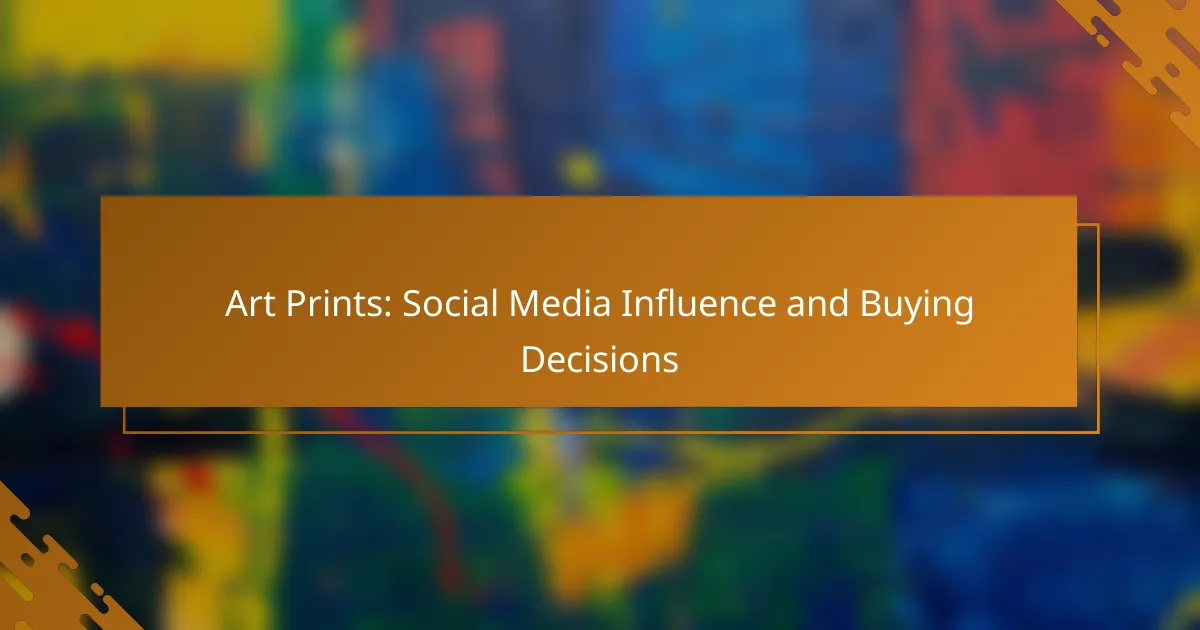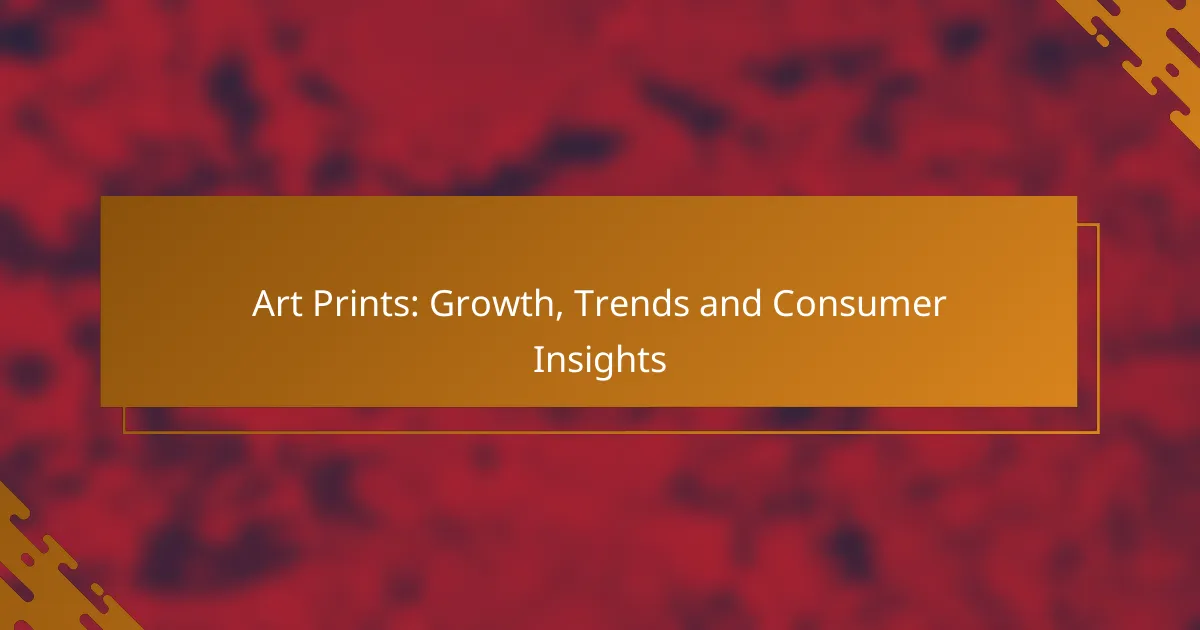Social media plays a crucial role in influencing consumer decisions when it comes to purchasing art prints. Platforms such as Instagram and Pinterest not only showcase stunning visual content but also foster community engagement, shaping perceptions and driving interest in art. By effectively leveraging these platforms, artists can enhance their visibility and connect with potential buyers, ultimately boosting their sales.
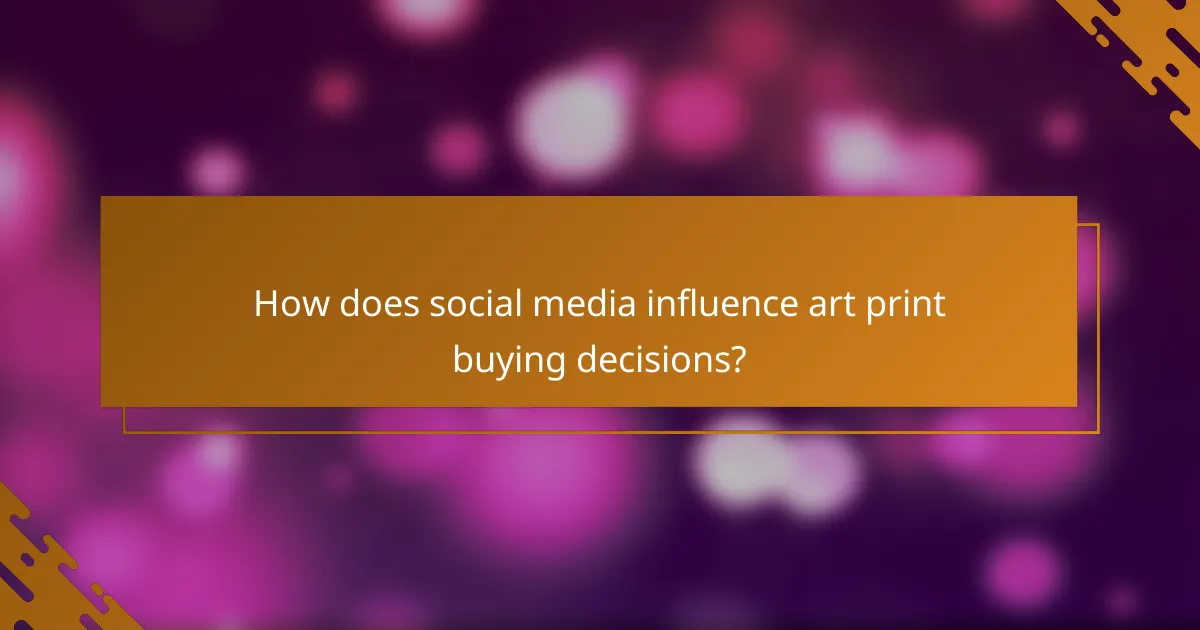
How does social media influence art print buying decisions?
Social media significantly impacts art print purchasing by shaping consumer perceptions and preferences. Platforms like Instagram and Pinterest showcase visual content that can drive interest and motivate purchases through curated aesthetics and community engagement.
Visual appeal drives engagement
The visual nature of social media platforms makes them ideal for showcasing art prints. High-quality images capture attention and encourage users to engage, often leading to shares and likes that amplify visibility. Art prints that are vibrant and well-composed tend to perform better, as users are more likely to remember and consider them for purchase.
When posting art prints, ensure that images are optimized for each platform’s specifications. For instance, Instagram favors square images, while Pinterest works better with vertical formats. This attention to detail can enhance engagement and drive more potential buyers to your work.
User-generated content builds trust
User-generated content (UGC) plays a crucial role in building trust among potential buyers. When customers share their experiences with art prints, it creates authentic testimonials that resonate with others. This form of social proof can significantly influence buying decisions, as prospective buyers often seek validation from their peers before making a purchase.
Encouraging customers to share photos of their purchased prints in their homes can enhance your brand’s credibility. Consider creating a unique hashtag for your art prints to facilitate easy discovery of UGC. This strategy not only showcases your work but also fosters a community around your brand.
Influencer endorsements increase visibility
Influencer endorsements can dramatically increase the visibility of art prints. Collaborating with influencers who align with your brand can introduce your work to a broader audience, often leading to increased sales. Influencers can provide a personal touch, showcasing how they incorporate your art into their lives, which can inspire their followers to make similar purchases.
When selecting influencers, consider their audience demographics and engagement rates to ensure a good fit. Micro-influencers, who often have more engaged audiences, can be particularly effective in niche markets like art prints. A well-structured partnership can lead to authentic promotion and a measurable boost in sales.

What are the best platforms for art print promotion?
The best platforms for promoting art prints include Instagram, Pinterest, and Facebook. Each platform offers unique features that cater to different aspects of marketing, from visual storytelling to community engagement.
Instagram for visual storytelling
Instagram is a powerful tool for visual storytelling, making it ideal for art print promotion. Artists can showcase their work through high-quality images, videos, and engaging captions that resonate with their audience.
Utilizing Instagram Stories and Reels can further enhance visibility, allowing artists to share behind-the-scenes content or time-lapse videos of their creative process. Regularly posting and interacting with followers can help build a loyal fan base.
Pinterest for inspiration and ideas
Pinterest serves as a visual discovery platform where users seek inspiration and ideas, making it a great fit for art print promotion. Artists can create boards that highlight their work alongside complementary styles or themes, attracting potential buyers.
Using keywords and hashtags effectively can increase the chances of appearing in relevant searches. Artists should consider linking their pins directly to their online shops or portfolios to facilitate easy purchasing.
Facebook for community building
Facebook excels in community building, allowing artists to connect with fans and fellow creators. By creating a dedicated page or group, artists can foster discussions, share updates, and engage directly with their audience.
Utilizing Facebook Events for exhibitions or live painting sessions can also drive interest and attendance. Regular interaction, such as responding to comments and hosting Q&A sessions, can strengthen community ties and promote art prints effectively.
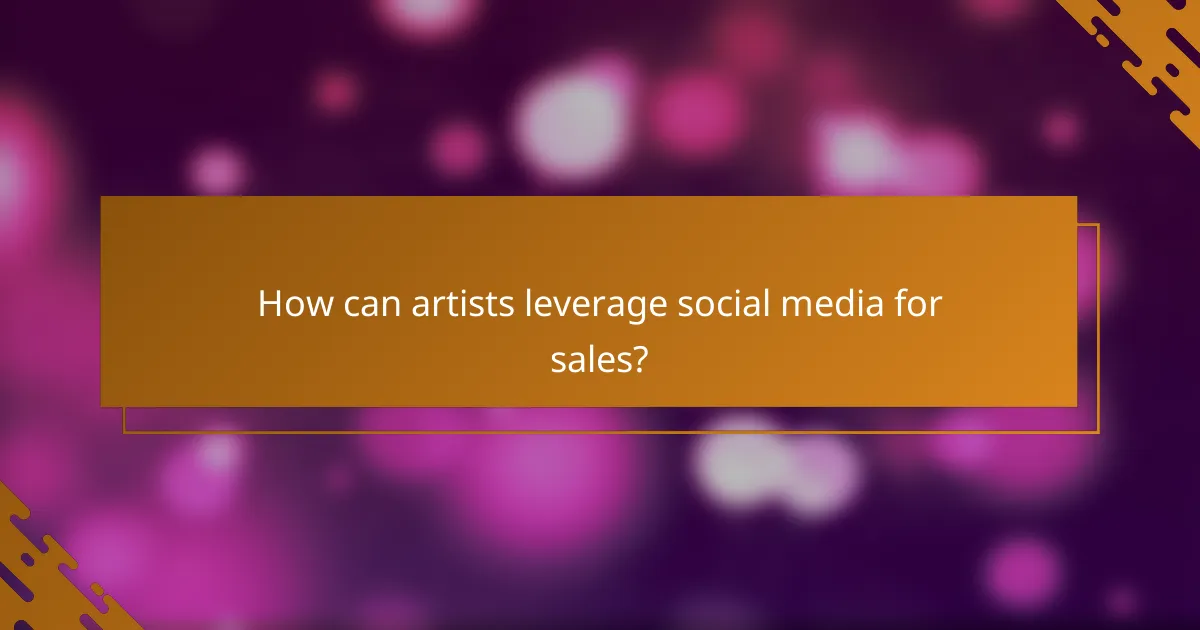
How can artists leverage social media for sales?
Artists can effectively leverage social media to boost sales by creating a strong online presence, engaging with their audience, and utilizing targeted advertising strategies. By strategically showcasing their art and connecting with potential buyers, artists can enhance visibility and drive sales.
Creating engaging content
Engaging content is crucial for capturing the attention of potential buyers on social media. Artists should focus on high-quality images of their artwork, behind-the-scenes videos, and storytelling that connects their art to personal experiences. Regularly posting diverse content can keep followers interested and encourage sharing.
Consider using formats like Instagram Stories or TikTok videos to showcase the creative process or highlight special features of the artwork. This not only entertains but also educates potential buyers about the value of the pieces.
Utilizing targeted ads
Targeted ads on platforms like Facebook and Instagram can significantly increase an artist’s reach. By defining specific demographics, interests, and behaviors, artists can ensure their ads are seen by individuals most likely to purchase their art. Setting a budget that aligns with marketing goals is essential for maximizing return on investment.
Artists should experiment with different ad formats, such as carousel ads to showcase multiple pieces or video ads for dynamic storytelling. Monitoring ad performance and adjusting strategies based on engagement metrics can lead to improved results over time.
Building a loyal follower base
Building a loyal follower base is vital for sustained sales through social media. Artists should engage consistently with their audience by responding to comments, hosting live Q&A sessions, and sharing user-generated content. This interaction fosters a sense of community and encourages followers to become advocates for the artist’s work.
Offering exclusive promotions or early access to new collections for followers can incentivize loyalty. Additionally, collaborating with other artists or influencers can introduce the artist to new audiences, further expanding their follower base.
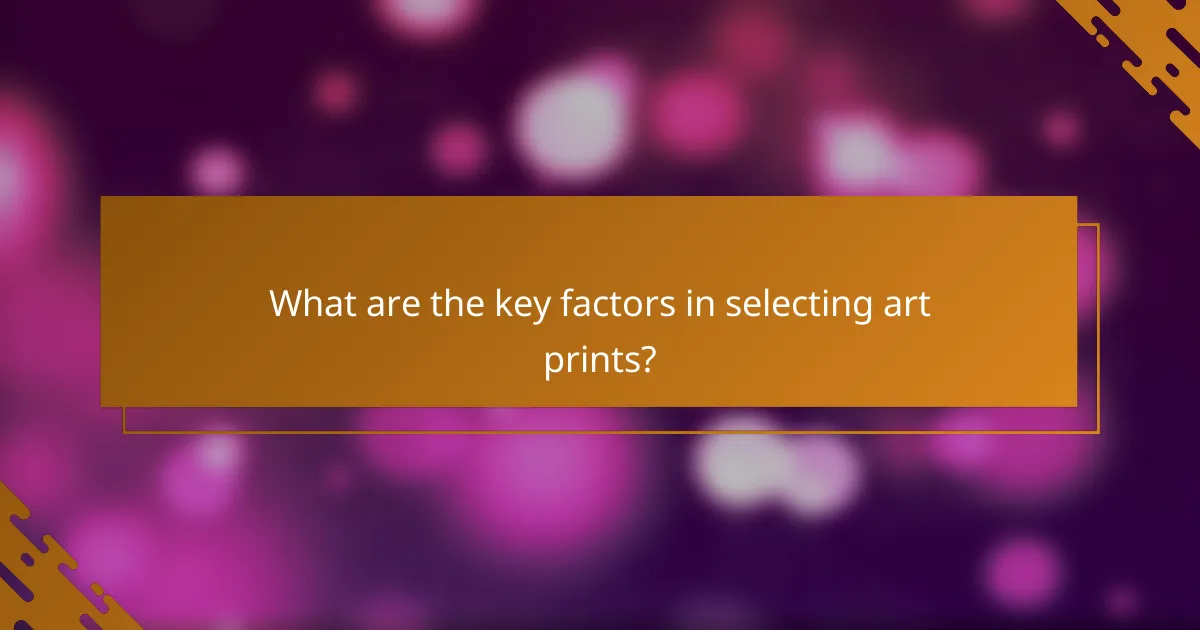
What are the key factors in selecting art prints?
When selecting art prints, key factors include the quality of materials, the reputation of the artist, and the available print sizes and framing options. These elements significantly influence both the aesthetic appeal and the longevity of the artwork.
Quality of materials used
The quality of materials directly affects the durability and visual impact of art prints. Look for prints made on acid-free paper or high-quality canvas, as these materials resist fading and yellowing over time. Additionally, consider the type of ink used; archival inks are preferred for their longevity and vibrancy.
When assessing quality, check for certifications or descriptions that indicate the print’s longevity, such as “museum quality” or “giclée print.” These terms often suggest a higher standard of production.
Artist reputation and recognition
The reputation of the artist can significantly influence the value and desirability of an art print. Established artists often command higher prices due to their recognition and previous sales history. Research the artist’s background, exhibitions, and previous works to gauge their standing in the art community.
Consider emerging artists as well; they may offer unique styles at lower prices. Supporting new talent can be rewarding, both personally and financially, as their work may appreciate in value over time.
Print size and framing options
Print size is crucial for ensuring the artwork fits well within your intended space. Common sizes range from small (around 30×40 cm) to large (over 100×150 cm), so measure your wall space before purchasing. Additionally, consider how the size complements your existing decor.
Framing options can enhance the overall presentation of the print. Choose frames that match your interior style—whether modern, rustic, or classic. Ready-made frames are often available for standard sizes, while custom framing can provide a more tailored look but may increase costs.

How do consumer reviews affect art print purchases?
Consumer reviews significantly influence art print purchases by shaping perceptions of quality and trustworthiness. Positive feedback can encourage buyers, while negative comments may raise doubts, impacting their final decision.
Positive reviews enhance credibility
Positive reviews build credibility for art prints by showcasing satisfied customers’ experiences. When potential buyers see high ratings and favorable comments, they are more likely to trust the seller and feel confident in their purchase. For example, an art print with multiple five-star reviews can stand out in a crowded market.
Additionally, positive reviews often highlight specific aspects of the art print, such as quality, color accuracy, and delivery speed. This detailed feedback can help buyers make informed decisions based on what matters most to them.
Negative feedback can deter buyers
Negative feedback can significantly deter potential buyers from purchasing art prints. A few low ratings or critical comments can raise red flags about the product’s quality or the seller’s reliability. For instance, if a buyer sees complaints about poor print quality or delayed shipping, they may choose to look elsewhere.
Moreover, negative reviews can amplify concerns about the authenticity of the artwork or the seller’s customer service. Buyers often weigh these factors heavily, especially when investing in higher-priced prints.
Review platforms influence decisions
Review platforms play a crucial role in shaping consumer decisions regarding art prints. Websites like Etsy, Amazon, and specialized art marketplaces provide spaces for customers to leave feedback, which can be easily accessed by potential buyers. The visibility of reviews on these platforms can directly impact a seller’s sales performance.
Furthermore, the overall rating on these platforms often serves as a quick reference for buyers. A seller with a high average rating across multiple platforms is likely to attract more customers, while those with inconsistent or low ratings may struggle to gain traction.

What trends are shaping the art print market?
The art print market is increasingly influenced by consumer preferences for customization and eco-friendly options. These trends reflect a growing desire for unique, personalized art pieces and a commitment to sustainability among buyers.
Customization and personalization demand
Consumers are actively seeking art prints that reflect their individual tastes and styles. Customization options, such as choosing colors, sizes, and even incorporating personal images, are becoming standard offerings from many artists and print shops.
For example, platforms that allow users to upload their own photos or select specific themes are gaining traction. This trend not only enhances customer satisfaction but also fosters a deeper emotional connection to the artwork.
Eco-friendly materials gaining popularity
There is a noticeable shift towards using sustainable materials in the production of art prints. Buyers are increasingly concerned about the environmental impact of their purchases, prompting artists to adopt eco-friendly inks and recycled paper.
Many consumers now prefer prints made with non-toxic, biodegradable materials, which can often be sourced locally. This trend not only supports environmental sustainability but also appeals to a growing market segment that prioritizes ethical consumption.
